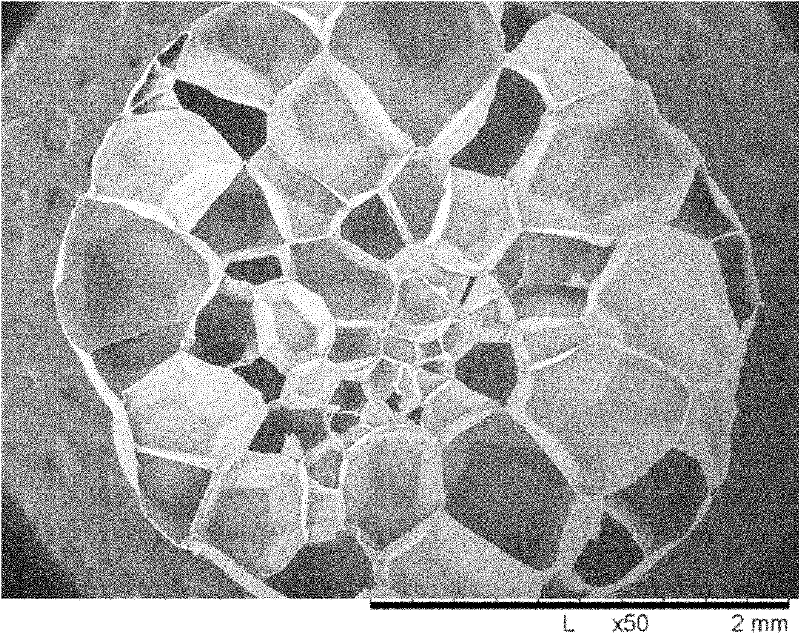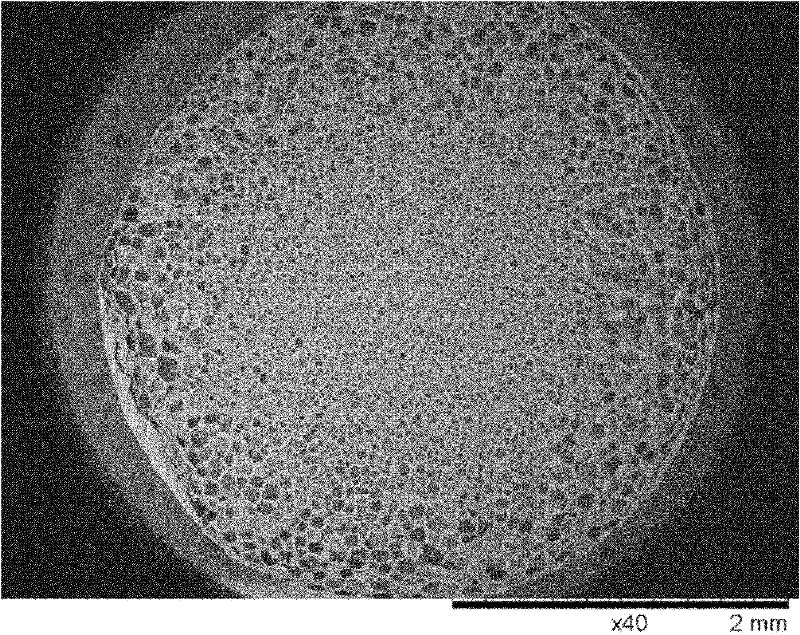Preparation method of biodegradable polymer foamed particles
A technology for degrading polymers and expanded particles is applied in the field of preparation of biodegradable polylactic acid or polylactic acid composite expanded particles, and can solve the problems of slow gaseous diffusion rate, poor foaming effect, and long production cycle. , to achieve the effect of short saturation time, conducive to industrialized implementation and easy operation
- Summary
- Abstract
- Description
- Claims
- Application Information
AI Technical Summary
Problems solved by technology
Method used
Image
Examples
Embodiment 1
[0035] Add semi-crystalline PLA (the product of NaureWorks company, the weight percentage of D-type lactic acid monomer in PLA resin is 4.2%) to the twin-screw extruder, and the PLA melt is transported to the extruder through twin-screw extrusion Die mouth, granulation after water cooling. The die chosen had 12 holes, each hole had a diameter of 0.6 mm, and the resulting PLA microparticles had a diameter of 0.6 mm.
[0036] The prepared PLA microparticles were put into an autoclave, and the pressure was 5MPa of CO 2 The high-pressure fluid makes the PLA microparticles reach saturation, the saturation temperature is 40°C, and the saturation time is 10h, and the saturated polylactic acid microparticles are obtained.
[0037] Open the air valve on the upper part of the autoclave to release the high-pressure gas, open the discharge valve on the lower part of the autoclave, and pass the saturated polylactic acid microparticles into a hot air foaming box at a temperature of 110 ° C...
Embodiment 2
[0040] In addition to the CO with a pressure of 5MPa 2 Mix high-pressure fluid with pentane (the volume content of pentane is 0.1%), except that the saturation time is 2h, other operations are the same as in Example 1, and polylactic acid foamed particles are obtained.
[0041] The prepared PLA expanded particles have smooth appearance structure. Scanning electron microscopy analysis of the quenched section of the PLA expanded particle sample showed that the cell density of the PLA expanded particle sample was 3.6×10 5 cells / cm 3 , The expansion ratio is 38.
Embodiment 3
[0043] Except that the polymer is a blend of PLA and PBS, the weight percentage of PBS in the blend is 10%, and the saturation time is 5h, other operations are the same as in Example 1 to prepare foamed polylactic acid composite particles.
[0044] The prepared PLA composite foamed particles have smooth appearance structure. Scanning electron microscope analysis was performed on the quenched section of the PLA composite expanded particle sample, as shown in figure 2 , showing that the cell structure of PLA composite expanded particles is closed, which shows that the introduction of PBS inhibits the opening phenomenon of PLA micro-foaming process. The cell density of PLA composite expanded particles is 2.6×10 5 cells / cm 3 , the expansion ratio is 32.
PUM
| Property | Measurement | Unit |
|---|---|---|
| particle diameter | aaaaa | aaaaa |
| diameter | aaaaa | aaaaa |
| diameter | aaaaa | aaaaa |
Abstract
Description
Claims
Application Information
 Login to View More
Login to View More - R&D
- Intellectual Property
- Life Sciences
- Materials
- Tech Scout
- Unparalleled Data Quality
- Higher Quality Content
- 60% Fewer Hallucinations
Browse by: Latest US Patents, China's latest patents, Technical Efficacy Thesaurus, Application Domain, Technology Topic, Popular Technical Reports.
© 2025 PatSnap. All rights reserved.Legal|Privacy policy|Modern Slavery Act Transparency Statement|Sitemap|About US| Contact US: help@patsnap.com



